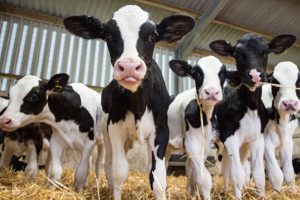Low Temperatures and Negative Energy Balance in Calves
D.C. Sockett DVM, PhD, Wisconsin Veterinary Diagnostic Laboratory
T.J. Earleywine PhD, Director of Nutrition Land O’ Lakes Animal Milk Products

Cold weather has arrived in the upper Midwest. Calf raisers know that cold temperatures increase the calf’s maintenance requirements for energy, but many do not know that the maintenance requirements also increase for protein and fat-soluble vitamins if the calf is ill from conditions like scours and pneumonia. Optimizing nutrition of sick calves can make the difference between a dead and a healthy calf.
It is important for livestock producers and veterinarians to understand that when the ambient temperature drops to 15 °F, feeding 3 quarts of milk (12.5% total solids) or a 22% protein, 20% fat milk replacer powder (12.5% total solids) twice a day will provide an 88 lb. calf with enough nutrition for less than 0.75 lbs/day of growth. However, if the calf is stressed further (draft, wet or dirty hair coat, develops scours, pneumonia etc.), there is insufficient energy and protein in the diet to meet the needs of the calf, and she will begin losing weight. Since calves are born with roughly 3-4% of body weight as fat, they will die if the negative energy balance continues for more than 3-5 days. Calf scours is a common problem on US dairy operations: therefore, winter feeding programs should be formulated to take into account the increased protein, fat-soluble vitamins and energy demands caused by calf scours. Also, calves should be provided with a jacket and kept in a dry, draft-free environment that is bedded with straw deep enough to cover their legs. Calves should be offered a highly palatable calf starter that is high in protein (18-22%) and energy beginning at 2-3 days of age and have access to free-choice (low sodium/not softened) warm water within 30 minutes of being fed milk or milk replacer.
Winter Feeding Program
Since ruminants do not metabolize fat as efficiently as non-ruminants, just providing more fat in the diet is the least satisfactory way of providing additional nutrition to the calf. The diet must be consistent (less than 1% daily variation in percent total solids) and have enough energy and protein so the calf can have efficient, lean growth, adequate immune function and healing of damaged tissue caused by events like scours or pneumonia. The dairy producer can pick one of the following 3 options:
- Continue to feed the calves 3 quarts of milk or milk replacer twice a day but increase the total solids content from 12.5 to 15%. To avoid problems, producers need to work closely with their dairy calf nutritionist if they choose this option.
- Continue feeding the calves twice a day but increase the volume of milk or milk replacer per feeding from 3 to 4 quarts.
- Feed the calves 3 quarts of milk or milk replacer 3 times a day instead of twice a day. There should be at least a 13-14 hour interval between the first and third feeding. This is the best option because calves do better when they are fed three times a day instead of twice a day.